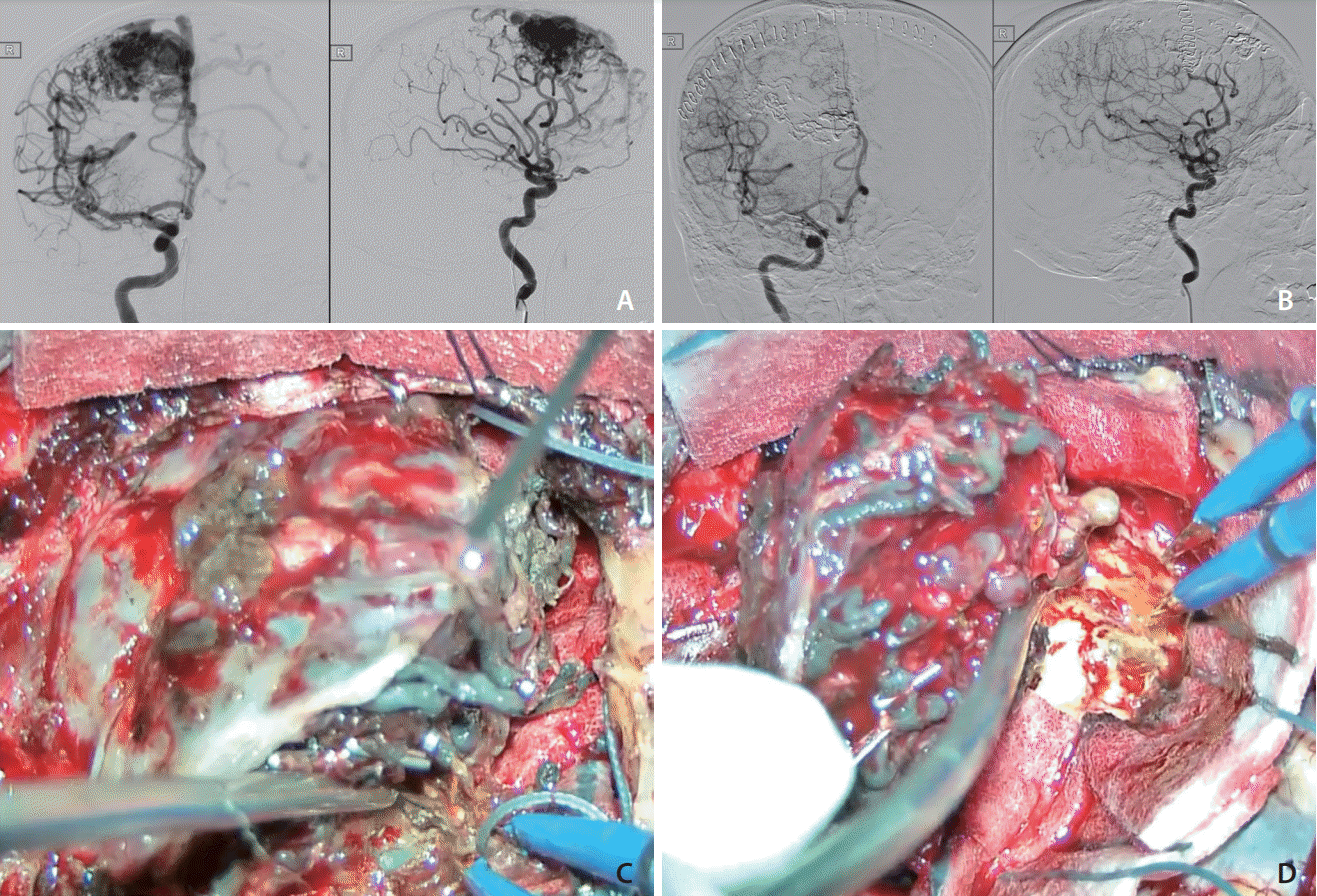1. Pierot L, Cognard C, Herbreteau D, Fransen H, van Rooij WJ, Boccardi E, et al. Endovascular treatment of brain arteriovenous malformations using a liquid embolic agent: results of a prospective, multicentre study (BRAVO). Eur Radiol. 2013; 23:2838–2845.

2. Lawton MT, Rutledge WC, Kim H, Stapf C, Whitehead KJ, Li DY, et al. Brain arteriovenous malformations. Nat Rev Dis Primers. 2015; 1:15008.

3. Chan DYC, Chan DTM, Zhu CXL, Kan PKY, Ng AY, Hsieh YS, et al. Awake craniotomy for excision of arteriovenous malformations? A qualitative comparison study with stereotactic radiosurgery. J Clin Neurosci. 2018; 51:52–56.

4. Vollherbst DF, Chapot R, Bendszus M, Möhlenbruch MA. Glue, onyx, squid or PHIL? Liquid embolic agents for the embolization of cerebral arteriovenous malformations and dural arteriovenous fistulas. Clin Neuroradiol. 2022; 32:25–38.

5. Koçer N, Hanımoğlu H, Batur Ş, Kandemirli SG, Kızılkılıç O, Sanus Z, et al. Preliminary experience with precipitating hydrophobic injectable liquid in brain arteriovenous malformations. Diagn Interv Radiol. 2016; 22:184–189.

6. Samaniego EA, Kalousek V, Abdo G, Ortega-Gutierrez S. Preliminary experience with precipitating hydrophobic injectable liquid (PHIL) in treating cerebral AVMs. J Neurointerv Surg. 2016; 8:1253–1255.

7. Akmangit I, Daglioglu E, Kaya T, Alagoz F, Sahinoglu M, Peker A, et al. Preliminary experience with squid: a new liquid embolizing agent for AVM, AV fistulas and tumors. Turk Neurosurg. 2014; 24:565–570.
8. Tam AKY, Chan DYC, Lim K, Poon D, Kam M, Cheung M, et al. Long term treatment efficacy & complications of hypofractionated stereotactic radiosurgery in brain arteriovenous malformations. J Clin Neurosci. 2020; 82(Pt B):241–246.

9. Wong GK, Kam MK, Chiu SK, Lam JM, Leung CH, Ng DW, et al. Validation of the modified radiosurgery-based arteriovenous malformation score in a linear accelerator radiosurgery experience in Hong Kong. J Clin Neurosci. 2012; 19:1252–1254.

10. Mason JR, Dodge C, Benndorf G. Quantification of tantalum sedimentation rates in liquid embolic agents. Interv Neuroradiol. 2018; 24:574–579.

11. Schmitt N, Floca RO, Paech D, El Shafie RA, Neuberger U, Bendszus M, et al. Imaging artifacts of nonadhesive liquid embolic agents in conventional and cone-beam CT in a novel in vitro AVM model. Clin Neuroradiol. 2021; 31:1141–1148.

12. Schmitt N, Weyland CS, Wucherpfennig L, Sommer CM, Bendszus M, Möhlenbruch MA, et al. The impact of software-based metal artifact reduction on the liquid embolic agent onyx in cone-beam CT: a systematic in vitro and in vivo study. J Neurointerv Surg. 2022; 14:832–836.

13. Samaniego EA, Derdeyn CP, Hayakawa M, Hasan D, OrtegaGutierrez S. In vivo evaluation of the new PHIL low viscosity in a swine rete mirabile model. Interv Neuroradiol. 2018; 24:706–712.

14. Mohr JP, Parides MK, Stapf C, Moquete E, Moy CS, Overbey JR, international ARUBA investigators, et al. Medical management with or without interventional therapy for unruptured brain arteriovenous malformations (ARUBA): a multicentre, non-blinded, randomised trial. Lancet. 2014; 383:614–621.

15. Elsenousi A, Aletich VA, Alaraj A. Neurological outcomes and cure rates of embolization of brain arteriovenous malformations with n-butyl cyanoacrylate or onyx: a meta-analysis. J Neurointerv Surg. 2016; 8:265–272.

16. Jayaraman MV, Marcellus ML, Hamilton S, Do HM, Campbell D, Chang SD, et al. Neurologic complications of arteriovenous malformation embolization using liquid embolic agents. AJNR Am J Neuroradiol. 2008; 29:242–246.

17. Taylor CL, Dutton K, Rappard G, Pride GL, Replogle R, Purdy PD, et al. Complications of preoperative embolization of cerebral arteriovenous malformations. J Neurosurg. 2004; 100:810–812.

18. Ledezma CJ, Hoh BL, Carter BS, Pryor JC, Putman CM, Ogilvy CS. Complications of cerebral arteriovenous malformation embolization: multivariate analysis of predictive factors. Neurosurgery. 2006; 58:602–611. discussion 602-611.

19. Hartmann A, Pile-Spellman J, Stapf C, Sciacca RR, Faulstich A, Mohr JP, et al. Risk of endovascular treatment of brain arteriovenous malformations. Stroke. 2002; 33:1816–1820.

20. Haw CS, terBrugge K, Willinsky R, Tomlinson G. Complications of embolization of arteriovenous malformations of the brain. J Neurosurg. 2006; 104:226–232.

21. Sirakov SS, Sirakov A, Minkin K, Hristov H, Ninov K, Penkov M, et al. Initial experience with precipitating hydrophobic injectable liquid in cerebral arteriovenous malformations. Interv Neuroradiol. 2019; 25:58–65.

22. Luessenhop AJ, Spence WT. Artificial embolization of cerebral arteries. Report of use in a case of arteriovenous malformation. J Am Med Assoc. 1960; 172:1153–1155.
23. Wong GK, Yu SC, Zhu XL, Kam MK, Poon WS. Use of onyx (a patented ethylene-vinyl alcohol copolymer formulation) embolisation of cerebral arteriovenous malformations in Hong Kong: initial experience. Hong Kong Med J. 2009; 15:359–364.
24. Flores BC, See AP, Weiner GM, Jankowitz BT, Ducruet AF, Albuquerque FC. Use of the Apollo detachable-tip microcatheter for endovascular embolization of arteriovenous malformations and arteriovenous fistulas. J Neurosurg. 2018; 130:963–971.

25. Mendes GAC, Kalani MYS, Iosif C, Lucena AF, Carvalho R, Saleme S, et al. Transvenous curative embolization of cerebral arteriovenous malformations: a prospective cohort study. Neurosurgery. 2018; 83:957–964.

26. Koyanagi M, Mosimann PJ, Nordmeyer H, Heddier M, Krause J, Narata AP, et al. The transvenous retrograde pressure cooker technique for the curative embolization of high-grade brain arteriovenous malformations. J Neurointerv Surg. 2021; 13:637–641.






 PDF
PDF Citation
Citation Print
Print




 XML Download
XML Download